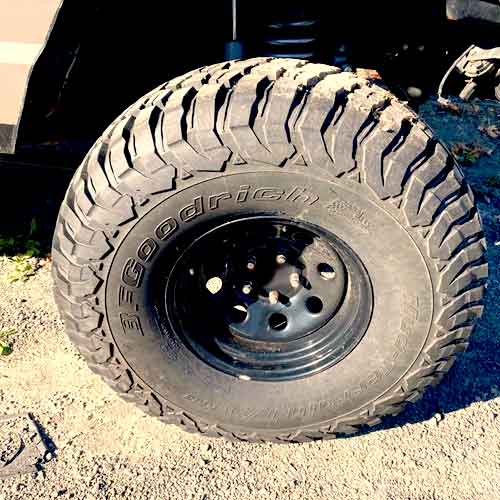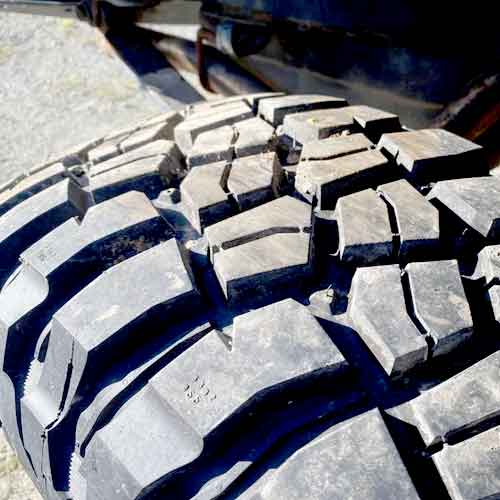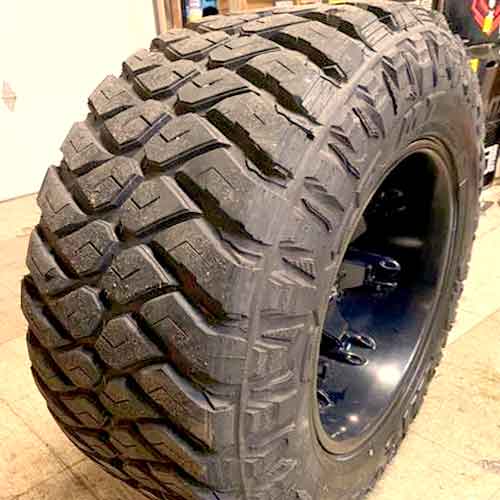The BF Goodrich KM3 and the Maxxis Razr MT are preferred by off-road enthusiasts for their ability to perform on tough terrains and provide reliable traction. However, it should be noted that these tires are not ideal for use on paved roads due to their tendency to be “noisy” and potentially not offering a comfortable ride, compared to other tire types.

In my professional opinion as a tire engineer, the BF Goodrich KM3 make a great paddle tire, that’s why its so great with sand, and lateral evacuation of mud/dirt/debris. Moreover, on roads, the tire offers superior comfort, and wet traction. The Maxxis Razr M/T on the other hand offers more durability and so with it, you get to have better rocky terrain traction and longer tread life.
Tire Facts
Starting with BF Goodrich KM3:
- It comes in a range of 56 sizes from 14 to 22 inches.
- With speed ratings of Q.
- Load Ratings of C, D, E, or F.
- Weight Range: 37 to 83 lbs.
- They have tread depth of 18/32″.
On the other hand, the Maxxis Razr MT:
- It comes in 53 sizes in 15 to 24″ rims.
- Speed Ratings available: Only Q.
- Load Ratings: C to F.
- Weight Range: 57 to 103 lbs.
- Tread depth: 18 to 20/32″.
Tread Pattern
Starting with BF Goodrich KM3, the tire makes a very self cleaning tread.

It features smaller blocks in the middle with thick sipes, and elongated shoulder lugs surrounding them.
All these lugs actually make wider lateral grooves, compared to narrower circumferential channels. And this way, they allow this tire to scoop the ground, throwing mud/dirt backward and as a result creating forward moving inertia.
The lateral moving mud is held out, and restricted form lodging in with the help of dual stone ejectors, (the bolder ones are seen between the shoulder lugs, and triangular ones are placed between them and the central blocks).
The shoulder lugs are the tire’s highlighting feature, and they cover a majority of the tread’s real estate.
Although they have minimal tread features towards inner side, their outer edges are very aggressive as they present staggered scoops, and join together on sidewalls forming chunkier lugs there as well.
On the other hand, the Maxxis Razr M/T also features a killer looking tread.

The 2 middle blocks that make up the tread pattern are arranged in a way that creates interconnected grooves that join with the outer longitudinal channels (though they are very tough passing).
These lugs are equipped with full-depth sipes, and reinforced foundational supports of secondary layers to provide a satisfactory on-road experience in both wet and dry conditions.
Though like BFG KM3, the majority of the tread’s area is covered with elongated shoulder lugs, having wider tread voids and bold stone ejectors in between.
Nonetheless, as you still get to have more biters on shoulders and with this the tire provides an appreciative rocky and muddy terrain performance as you’ll see, in their respective topics.
Durability
Durability is dependent on internal layers, and here although both tires offer 3 ply polyester cover with 2 steel belts, the BF Goodrich KM3 only yields a single cap ply on top, whereas Maxxis M/T gives you with 2.
Though Maixxis having more layers also increases its weight a lot, and that compromises on some key areas (of performance), as you’ll find out in the upcoming sections.
(So tire manufacturers have to find a middle ground here).
Highway Performance
Traction, steering, and cornering ability are all important factors to consider when evaluating the dry performance of mud terrains tires.
And so I’ve examined each of these individually below.
Directional Grip
When it comes to mud-terrain tires, you can’t really expect too much out of them here, as their aggressive structure isn’t able to grip effectively and it get further compromised with speed, that’s why they are mostly rated up to Q in speed ratings.
And although both tires here have that, the Maxxis Razr M/T is able to provide better gripping capabilities, still.
That’s because it features lugs which are more streamlined towards pavements.
It’s 2 ribs in the middle, carrying leaf shaped lugs, are more compacted together, and with their longitudinal orientation, they provide better consistency in connecting with the road while moving directionally.
And so as a result, you get shorter stopping distances in comparison on this tire.
Dry Handling
The overall structure and shoulders come in to action on sides, and here both areas render BF Goodrich KM3 better.
As explained in the tread section above, the tire has more lateral orientation of it’s lugs, where even the central ribs look like they are a part of its shoulders.
That’s why moving on corners, the tire offers superior lateral g forces.
Steering Response
Tire responsiveness, a measure of how well a tire responds to steering inputs, can be influenced by factors such as weight and sidewall design, which can affect the continuity of contact between the tire and the road.
And so with better lateral maneuvering capability, combined with lighter weight (reaching up to only 83 lbs), the BF Goodrich KM3 provides superior handling feedback.
The Maxxis M/T on the other side, goes up to 103 lbs with it’s extra cap ply, and it causes it to under-steer a lot, compromising on steering sensitivity.
Moreover, the tire’s tread depth is 2/32″ more (on their largest sizes), and because of this, a lot more energy gets wasted in to flexing the lugs.
Wet Traction
When a tire comes in contact with watery surface, most of it passes through the grooves (and out of the tire), whereas the little bit that get left behind comes in contact with the lugs, which can only be cleaned off with sipes.
That’s the reason why sipes are important, but more siping is also directly proportional to faster wear, and that especially goes for mud tires, that’s why you don’t see enough on both of these tires here.
Though still, the BF Goodrich KM3 offers better efficacy out of the two, as this tire features more silica in it’s composition, basically, and so it’s rubber is more flexible comparatively. This allows sipes to work in a better way (as they literally suck water particles).
The Maxxis M/T on the other side, offers very limited sipes, and even those don’t get to flex properly due to the tire’s stiffer rubber compound.
Though both tires are pretty great at evacuation water out of groves, so in terms of hydroplaning resistance, there isn’t any problem.
Fuel Consumption
Fuel economy is impacted by rolling resistance, which is determined by the tire’s weight and the stickiness of its tread.
So here with heavier weight the Maxxis M/T gets to burn more fuel. Whereas, with 20 pounds lighter, the BF Goodrich KM3 provides better efficacy (though it’s not so great either, compared to other M/Ts).
Tread Wear
Out of these two, the Maxxis Razr M/T provides better mileage, as it does everything right here.
It yields a dual rubber compound where on top, it’s ribs are optimized to bear pressure on them equally, so with that, all parts even out great.
Moreover, even though the tire is heavier in weight, and we saw how it generated larger rolling resistance, it’s stiffer composition and larger tread depth still takes a lot more time to get burned off.
Whereas the softer rubber compound of BFG KM3 (having only 18/32″ of tread depth), burns much faster.
For Your Info: I believe in the mud terrain category, the Pro Comp Xtreme MT2 (review), gives you the best wear life.
Comfort and Noise
Talking about comfort first, with softer rubber having high silica density, the BF Goodrich KM3 provides a spongy compound to absorb the bumps both on and off road.
Furthermore, the tire has a single light weight cap ply which ensures the inner construction is not rigid, and this further adds to the soaking of the impacts.
So comfort wise the tire is okay.
The Maxxis Razr M/T although offers thicker rubber of tread (with it’s greater tread depth), it’s stiffer composition is not efficient enough to settle down the vibrations.
Though the tire does great with noise.
As noise enters through the shoulder voids (most of it anyways), the KM3 forming such wider lateral grooves there allow a lot of that air to hit around, creating more noise pollution.
Maxxis Razr M/T not only offers closed up lugs there (in comparison), but with a more random lugs placement, it provides better pitch sequencing (variable pitch).
For Your Info: Best tire for tread noise in M/Ts is Falken Wildpeak M/T (review).
Winter Traction
Although both of these tires are not 3 peak mountain snowflake rated, they are still okay with deeper snow, as their lugs lugs scoop the snow out and backwards and create forward momentum.
But here the BF Goodrich KM3 is still a better pick overall, as it’s rubber doesn’t become a rock like the Maxxis M/T
In other words, the Maxxis M/T is not good at enduring freezing temperatures, though the tire does offer better snow grabbing abilities, but it’s of no use, (when things get below 5 degrees).
Off Road Traction
Mud tires are not just great on mud, they provide superior traction in all kinds of rugged terrains, so let’s see how both boys here performed next to each other.
On Sand
On sand you need a light tire, with a larger section width.
And by no means both of these tires are what you’d call “light”, though still the BF Goodrich KM3 gets to be lighter comparatively.
And since it’s lugs are pasted on a larger sidewall’s real estate, it gets to provide superior footprint with lowered air pressure. So it provides better results compared to Maxxis here.
On Mud
On mud filled tracks, you need self cleaning tread, and with mud-terrain tires, you can never go wrong here, as they are the most capable for this terrain, stating the obvious.
Having said that, both of our boys here simply offer great results on all types of muddy terrains. They can scoop efficiently and their grooves take out the excess mud, avoiding tread to get packed.
Here both are simply great, as both offer scooping lugs which simply throw the mud around with staggered sides, where their wider grooves self clean simultaneously.
The BFG KM3 provides efficient mud evacuation with its elongated lugs and lateral (wider) grooves, whereas the Maxxis Razr M/T provides better scooping (throwing mud backwards and creating forward momentum as a result).
So comparing both, you cant really put one tire over the other.
On Rocks
The Maxxis Razr MT is simply awesome on rocks. The tire holds on to all kinds of rocky terrains, like there’s no tomorrow.
It features a soup of circumferential and lateral traction with it’s countless biters everywhere. And it’s side biters are although not as flexing, with lowered air pressure, that’s not an issue anymore.
The BF Goodrich KM3 on the other side, provide amazing lateral traction with it’s sidewall lugs, especially on wet rocks, and the tire’s extended shoulder lugs provide a noteworthy foot print, when pressured down where it’s deep biters ensure the grip is stayed in tact at all times.
Leave With This
Maxxis Razr M/T being a heavier and stiffer tire lacks in overall steering response, fuel economy, and wet traction.
Though it’s better when it comes to rocky terrains, deals better with noise, and gives you a longer tread life.
On the other side, the BF Goodrich KM3 provides you with superior wet and snow traction, better overall comfort (bumps absorption), and great mud/dirt evacuation capabilities.
It’s resemblance to paddle tires also make it one of the best ones out there for sandy terrains.